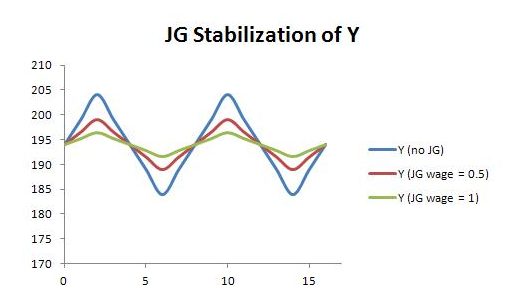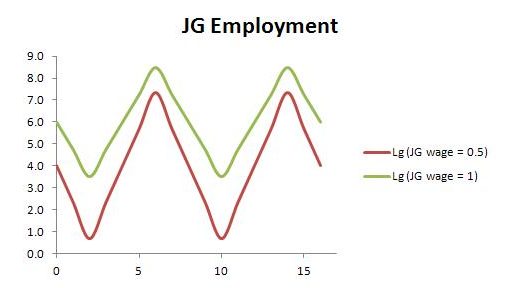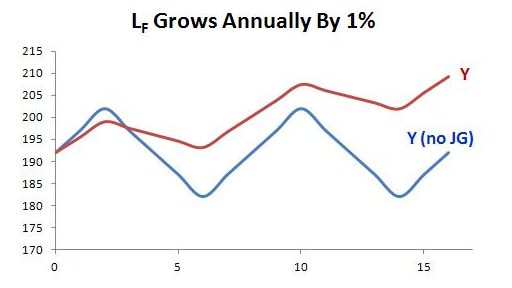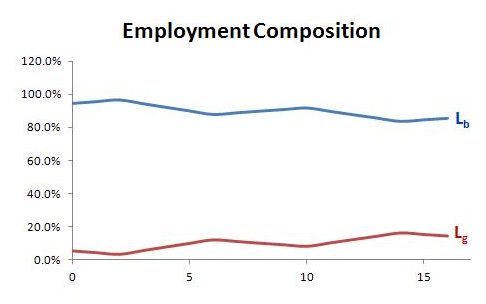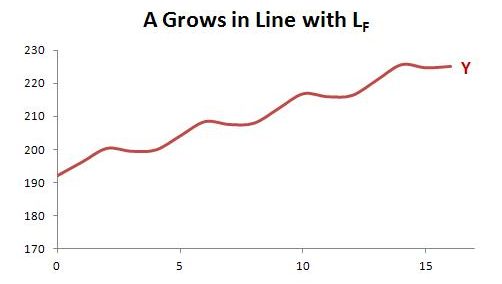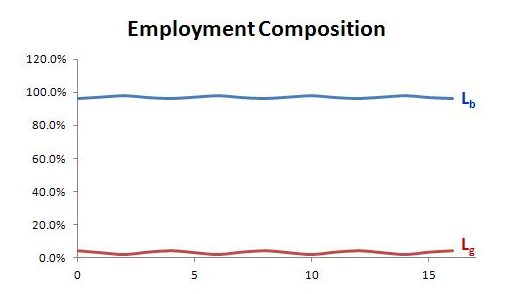A recent post considered one way of including a job guarantee in the income-expenditure model. Doing so makes it possible to represent various macro effects of a job guarantee within the model. An obvious effect is that the program would deliver a degree of demand stabilization. An effect that is perhaps not quite so obvious is the way in which a job guarantee would ensure supply-side changes in the economy automatically impact on demand, actual output and employment. Before illustrating a few of these effects, the modified income-expenditure model will be briefly outlined and tailored to present purposes. A fuller discussion of the model is provided in the earlier post. The Model In the basic income-expenditure model, total output (Y) converges on the level Y = A/α, where A is net
Topics:
peterc considers the following as important: Job & Income Guarantee
This could be interesting, too:
peterc writes Macro Dynamics with a Job Guarantee – Part 6: Price Stabilization
peterc writes Macro Dynamics with a Job Guarantee – Part 5: Price Level
peterc writes Macro Dynamics with a Job Guarantee – Part 4: Dynamic Stability
peterc writes Macro Dynamics with a Job Guarantee – Part 3: Adjustment Process
A recent post considered one way of including a job guarantee in the income-expenditure model. Doing so makes it possible to represent various macro effects of a job guarantee within the model. An obvious effect is that the program would deliver a degree of demand stabilization. An effect that is perhaps not quite so obvious is the way in which a job guarantee would ensure supply-side changes in the economy automatically impact on demand, actual output and employment. Before illustrating a few of these effects, the modified income-expenditure model will be briefly outlined and tailored to present purposes. A fuller discussion of the model is provided in the earlier post.
The Model
In the basic income-expenditure model, total output (Y) converges on the level Y = A/α, where A is net autonomous expenditure and α is the marginal propensity to leak from the circular flow of income to taxes, saving and imports. Introducing a job guarantee into the model modifies this to:
where Gg is the government’s spending on the job guarantee. The main preoccupation of the earlier post was to find an expression for this component of government spending, which adjusts automatically to variations in the number of people who accept the standing offer of a job. It was shown that within the model:
In this expression, LF is the level of employment associated with full employment. This level of employment is determined exogenously by workers themselves in the sense that a job at the living wage can always be obtained in the job-guarantee sector. (A more sophisticated approach might also allow for endogenous changes in the level of LF by explicitly recognizing that some people unwilling to accept job-guarantee jobs will exit employment in a downturn, due to layoff, and re-enter in an upturn.) The cost of the job-guarantee program per unit of labor is wL/ϕ, where wL is the living wage paid per unit of job-guarantee employment and ϕ is the share of wages in total job-guarantee costs. Productivity in the broader economy is denoted ρb. As discussed in the earlier post, productivity in the job-guarantee sector can be interpreted as being equal to the living wage (ρg = wL). The difference in productivity between the job-guarantee program and the broader economy implies that average productivity for the economy as a whole (ρ) varies with the composition of employment between the two sectors (assuming ρb > ρg).
Since the present focus is on total output and employment, it is convenient to substitute the expression for job-guarantee spending given by (2) into (1). Rearrangement (eventually) gives:
Of the economy’s total output, Yb is the output produced within the broader economy and Yg = ϕGg is the amount produced in the job-guarantee sector. An expression for output of the broader economy can be obtained by subtracting ϕGg (= Yg) from both sides of (1), substituting for Gg and solving for Yb. An expression for Yg can be obtained simply by multiplying the expression for Gg in (2) by ϕ.
Expressions (3) to (5) show that, once a job-guarantee is introduced, Y, Yb and Yg can be affected by exogenous changes on both the demand and supply sides of the economy. On the demand side, there is the familiar effect of exogenous changes in autonomous expenditure (A) or changes in the marginal propensity to leak from the circular flow of income (α). On the supply side, an exogenous change in the level of total employment (LF) will directly bring about changes in Yg and hence Y and subsequently Yb. Exogenous changes in other supply-side factors – the living wage (wL), the wage share in job-guarantee costs (ϕ) and productivity in the two sectors (ρb and ρg = wL) – make themselves felt through their impact on the size of the multipliers applying to A and LF.
Demand Stabilization
Like other automatic stabilizers, a job guarantee would somewhat moderate fluctuations in total demand and output. In the following diagram, fluctuations in output are generated by arbitrarily letting private investment cycle between a high of 35 and a low of 25, beginning and ending at 30. The marginal propensity to leak is assumed to be 0.5, productivity in the broader economy 2, and the wage share in job-guarantee costs 0.67. Full employment is set at 100. Net autonomous spending other than private investment is set to 67 in the absence of a job guarantee, 64 when the job-guarantee wage is 0.5 and 58 when the job guarantee wage is 1. These values for net autonomous spending other than private investment are chosen to ensure that the initial and final levels of output are the same for the three scenarios, since the focus here is on illustrating the dampening of fluctuations.
Within the model, the stabilization effects are stronger when the living wage paid to job-guarantee workers is increased relative to productivity in the broader economy. This does not account, though, for the possibility that a higher living wage might encourage some employed workers to switch from the broader economy to the job-guarantee sector.
Fluctuations in the economy as a whole (represented by Y) are dampened more than fluctuations in the broader economy (represented by Yb). The greater volatility of Yb is illustrated in the next diagram. The values for the parameters and private investment are the same as in the previous diagram. Net autonomous spending other than private investment is set to 62 (rather than 58) when the living wage is 1, but given the same settings as before in the other scenarios.
To a significant degree workers would be sheltered from the volatility in the broader economy through variations in job-guarantee employment:
A Supply-Side Effect
From a Keynesian or Kaleckian perspective, a mere increase in potential output (such as through an increase in labor-force participation or an improvement in productivity) does not necessarily bring about an automatic increase in output and employment. The greater productive potential is only realized if demand happens to be sufficient to sustain the higher level of output.
The job guarantee introduces a mechanism through which an increase in labor-force participation directly initiates an expansion of demand, actual output and employment. The causation, in these instances, runs from individual decisions to enter the labor force to accept the job-guarantee offer, to an increase in employment, to an activated expenditure by government on the program and increased income and output, to multiplier effects in the broader economy.
Similar effects can be partially present under some other policy measures, though the effects are likely to be weaker and less direct. For instance, when government pays an unemployment benefit that is not contingent on prior employment (this occurs in Australia, for instance), a decision by a jobless person to enter the labor force activates, subject to administrative checks and with a delay, a benefit payment. This does not represent a direct addition to demand because the benefit payment is treated as a ‘transfer’ (or negative tax) in the National Accounts. Even so, to the extent the benefit payment is used for consumption expenditure (and mostly it will be), there will be an impact on demand with a subsequent multiplier impact on the economy. Such a policy therefore does enable a supply-side change to have an impact on demand, actual output and employment, though the channel is less direct. If the benefit is means-tested (this is the case in Australia), the channel will be narrower than otherwise.
Under a job guarantee, exogenous growth of the labor force would cause an increase in output and employment. The increase in output would be enabled by an automatic expansion of job-guarantee spending and an inducement of additional private consumption. Suppose, initially, that there is no change in the assumed behavior of other exogenous variables or parameters. In that case, although employment in the broader economy would expand, it would not keep pace with the expansion of the job-guarantee sector. This is illustrated in the next two diagrams. It is assumed that the level of employment associated with full employment (LF) grows by 1 percent each period. The other exogenous variables and parameters take the same values as in earlier examples except that the living wage paid to job-guarantee workers is always 0.5 in the following scenarios.
For employment in the broader economy to grow in line with total employment, it would be necessary for autonomous spending to keep pace with the growth in the labor force. In the next two diagrams, it is assumed that autonomous spending other than private investment grows by the same rate as the labor force. Growth in private investment is also assumed to occur, but with an arbitrary delay of four periods.
Concluding Remark
The automatic translation of extra supply potential into actual demand, output and employment seems quite an interesting feature of the job guarantee.
Academic Treatments of the Job Guarantee’s Macro Effects
A more sophisticated and comprehensive empirical analysis of a job guarantee’s macro effects, which employs the Fair model (an econometric model developed in the tradition of the Cowels Commission by Ray Fair), is provided by Scott Fullwiler in a 2005 paper.
A recent paper by Warren Mosler and Damiano Silipo focuses on price-stabilizing features of the job guarantee.
Introductions to the Income-Expenditure Model
For newer readers, an introduction to the income-expenditure model is provided in:
Bill Mitchell – Spending Multipliers
Earlier heteconomist posts on the topic, with the easiest posts listed first, include:
Short & Simple 16 – The Expenditure Multiplier and Income Determination
Short & Simple 18 – Income Determination in a Closed Economy





